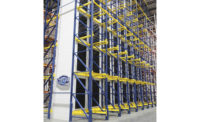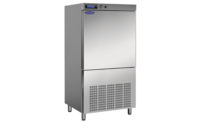
What’s it like to develop innovative technology? You could say that it’s a blast.
Research engineers at the Tippmann Group say they developed a proven blast freezing system that reduces both energy and labor costs. Tippmann, the Fort Wayne, Ind., parent to Interstate Warehousing and Tippmann Construction, has introduced the Quick Freeze Racking Zone (QFR Zone), an in-rack, easy-access storage alternative to traditional, sealed blast freezing rooms.
“We – and others – have tried to freeze using rack applications in the freezer room and never got the true blast freezing performance,” admits Steve Tippmann, executive vice president. “Then we came up with this method of [forced] airflow between the pallet spacers. It’s all about the airflow … and that’s what makes QFR successful where other attempts have not worked. The airflow between pallet spacers – a process in which we force consistent airflow – is what makes this unique and effective.”
Tippmann says he revisited the blast freezing process in August 2008 when the company wanted to (1) modernize blast freezing and better utilize a directed move warehouse management system, (2) cut energy costs, and (3) reduce labor hours needed to handle blast freezer pallet loads.
Tippmann engineers developed and installed a test version of QFR at Hatfield Quality Meats in Hatfield, Pa. Once officials were satisfied with test results, Tippmann built a QFR Zone for Hatfield’s new distribution facility, where it has been used since September 2009.
“They’ve told us the performance is fantastic and it already has exceeded our guarantee of performance,” says Tippmann. “And when I took a different customer there to see it, [their executives] were all smiles.”
Positioned anywhere in a main freezer storage room, the QFR Zone includes an air plenum (controlled air shaft) with single-deep rack storage on both sides. The patent-pending Tippmann process then uses pallet guides, dock-type seals and adjustable wall curtains to custom fit and connect one exposed side of a pallet to the plenum chamber.
Sitting atop that plenum chamber is a specialized plenum fan, which can create suction pressure adequate enough to pull 150 feet of air per minute passing through the pallet spacers, Tippmann says. That’s compared to an estimated 5 feet of airflow per minute in traditional settings – where most air deflects off and around the pallet load.
With superior airflow, Tippmann says warehouse operators can freeze faster (cutting time by as much as two-thirds) and raise refrigerant temperatures to reduce energy consumption in the engine room. The industry premise: every degree below 0

